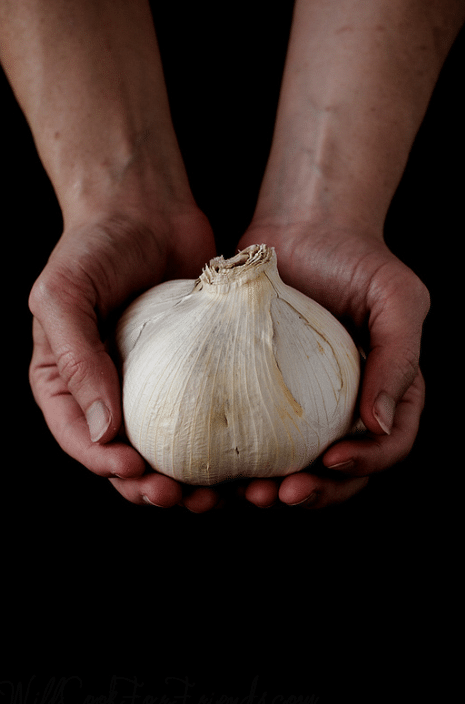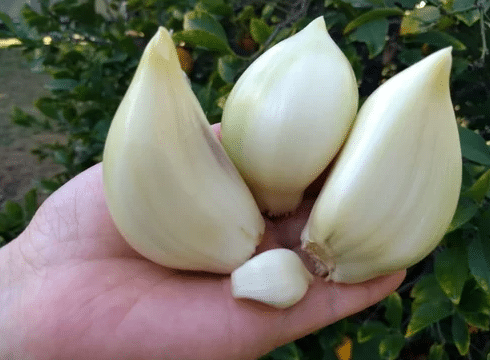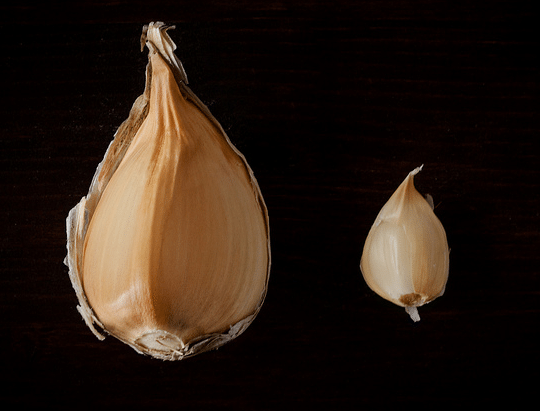Elephant garlic – the name alone sparks curiosity. Is it truly garlic? Is it the size of an elephant? While not quite elephantine in scale, this impressive bulb, often mistaken for garlic, is a fascinating ingredient with a unique flavor profile and a surprising number of culinary uses. Join us as we delve into the world of elephant garlic, uncovering its secrets, dispelling myths, and exploring why this gentle giant deserves a place in your kitchen.
What is Elephant Garlic?
Despite its name and imposing size, elephant garlic (Allium ampeloprasum var. ampeloprasum) is not a true garlic but rather a type of leek. It belongs to the same family as onions, shallots, and chives. Native to Central Asia, elephant garlic has been cultivated for centuries for its mild flavor and impressive size.
How Elephant Garlic Grows
Elephant garlic grows in large bulbs, often reaching the size of a softball or even larger. Each bulb typically contains 4-6 cloves, which are significantly larger than regular garlic cloves. The plant itself is also quite impressive, with tall, sturdy stalks that can reach heights of up to 6 feet.
A Gentle Giant in the Kitchen
Elephant garlic’s flavor is noticeably milder than that of regular garlic. It offers a delicate, subtly sweet garlic flavor with hints of onion and leek. This makes it a versatile ingredient that can be used in dishes where the intense flavor of regular garlic might be overpowering.

Detailed Product Specifications
Below is a table that outlines the basic information about elephant garlic, including its types, components, and characteristics. This table also includes a comparison with regular garlic to highlight the differences.
| Attribute | Elephant Garlic | Regular Garlic |
|---|---|---|
| Type | Allium ampeloprasum | Allium sativum |
| Flavor | Mild, sweet | Strong, pungent |
| Clove Size | Large (up to a fist size) | Small to medium |
| Bulb Size | Very large | Medium to large |
| Plant Height | Up to 4 feet | Up to 3 feet |
| Growing Season | Fall to early summer | Fall to early summer |
| Harvest Time | 240 days | 180-210 days |
| Nutritional Content | Low in calories, high in vitamins C and B6, manganese | Low in calories, high in vitamins C and B6, manganese |
| Culinary Uses | Roasting, grilling, raw | Cooking, flavoring, medicinal |
| Medicinal Uses | Similar to garlic but milder | Antibacterial, antifungal, antiviral |
Applications of Elephant Garlic
Elephant garlic is versatile and can be used in various fields. Here are some of the primary applications:
- Culinary Uses:
- Roasting: Its large cloves are perfect for roasting, creating a sweet, caramelized flavor.
- Grilling: Adds a mild garlic flavor to grilled vegetables and meats.
- Raw Dishes: Can be sliced thinly and added to salads for a subtle garlic taste.
- Soups and Stews: Enhances the flavor of soups and stews without overpowering other ingredients.
- Medicinal Uses:
- Antimicrobial Properties: Similar to regular garlic, it can help fight bacterial and fungal infections.
- Immune Boosting: Contains compounds that can enhance the immune system.
- Digestive Health: Its mild flavor makes it suitable for those with sensitive stomachs.
- Gardening Uses:
- Companion Planting: Helps deter pests from other plants in the garden.
- Ornamental: Its tall stalks and large bulbs can be an attractive addition to garden landscapes.
- Cosmetic Uses:
- Skin Care: Garlic extracts are sometimes used in skincare products for their antimicrobial properties.
- Hair Care: Can be used in hair masks to promote scalp health.
Advantages and Disadvantages of Elephant Garlic
Here’s a comparison table outlining the pros and cons of using elephant garlic:
| Aspect | Advantages | Disadvantages |
|---|---|---|
| Flavor | Mild and sweet, suitable for subtle dishes | May be too mild for strong garlic flavor lovers |
| Size | Large cloves make peeling and preparation easier | Larger size can be cumbersome for some recipes |
| Health Benefits | Similar health benefits to regular garlic | Lower concentration of allicin compared to regular garlic |
| Versatility | Can be used in a variety of culinary and medicinal applications | Limited availability in some regions |
| Growing | Attractive plant, good for companion planting | Requires specific growing conditions |
Elephant Garlic Fun Facts: Intriguing Tidbits About This Gentle Giant:


- Chef’s Secret Weapon: Elephant garlic has become increasingly popular among chefs, not just for its size, but for its versatility. The milder flavor allows for creative uses without overpowering other ingredients. It’s often roasted whole and pureed for sauces, or thinly sliced and fried into crispy garnishes.
- A Giant Among Giants: The quest for the largest elephant garlic bulb is a source of friendly competition among growers. The current record holder weighed in at a staggering 2.5 pounds – imagine the meals that could be made with that!
- Nutritional Powerhouse: Don’t let its mild flavor fool you, elephant garlic packs a nutritional punch. It’s a good source of:
- Vitamin C: This powerful antioxidant helps boost the immune system, protecting your body from damaging free radicals. It’s also essential for collagen production, keeping skin healthy and elastic.
- Vitamin B6: Crucial for brain health, vitamin B6 helps in the production of neurotransmitters that regulate mood, sleep, and cognitive function. It’s especially important during pregnancy and infancy for healthy brain development.
- Manganese: This trace mineral plays a role in bone health, metabolism, and wound healing.
- Scapes? Not Quite: Unlike its garlicky cousin, elephant garlic rarely produces scapes – those curly green stalks that are a springtime delicacy. While you won’t be making elephant garlic scape pesto, you can enjoy the milder flavor of the bulb in countless other ways.
Frequently Asked Questions (FAQ)
1. How is Elephant Garlic Different from Regular Garlic?
Elephant garlic differs from regular garlic primarily in size and flavor. It typically produces much larger bulbs and cloves, often reaching the size of a small fist. The flavor is also milder and sweeter compared to the strong, pungent taste of regular garlic. Additionally, elephant garlic is more closely related to leeks than to true garlic, which explains its distinct characteristics.
2. Can Elephant Garlic Be Used Medicinally?
Yes, elephant garlic can be used medicinally, similar to regular garlic. It possesses antimicrobial properties, which can help fight bacterial and fungal infections. It also has immune-boosting compounds that can support overall health. However, due to its milder nature, it may have a lower concentration of allicin, the compound responsible for many of garlic’s health benefits. It’s advisable to consult with a healthcare provider before using it as a primary treatment for health conditions.
3. How Should Elephant Garlic Be Stored?
Proper storage of elephant garlic is essential to maintain its freshness and prevent spoilage. After harvesting, the bulbs should be cured by letting them dry in a cool, well-ventilated area for a few weeks. Once cured, elephant garlic should be stored in a cool, dry place with good air circulation. Avoid storing it in plastic bags or airtight containers, as this can lead to mold growth.
- More details on garlic varieties at Ultimate Garlic Guide
- How to Growing at Elephant Garlic:Your Best Growing Guide
